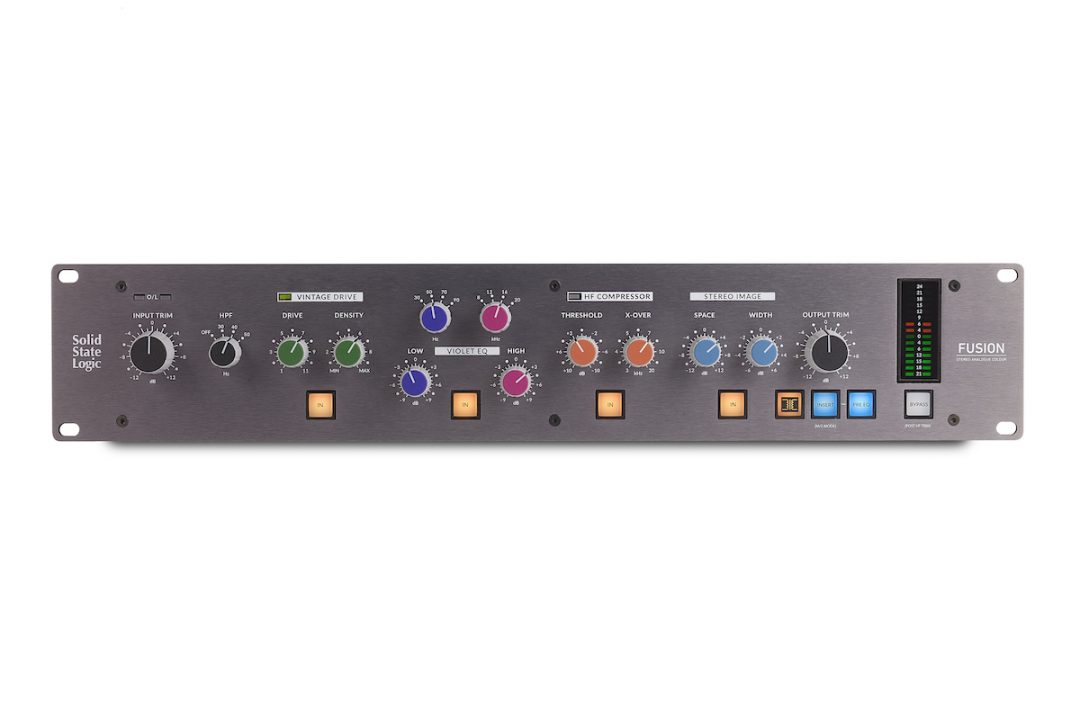Founded in 1969, Solid State Logic is renowned as one of the finest manufacturers of high-end consoles and recording equipment in the world. In the ’80s, their famed 4000 E series console set the benchmark for recorded music, becoming a major part of ‘the sound’ of the era. In more recent years, SSL began catering to the project studio market with products like the SiX desktop mixer, SSL2 2×2 interface, 500-series preamps and equalizers, and the SSL Fusion.
What is the SSL Fusion?
Succinctly described as a Stereo Analogue Colour tool, Fusion is a hardware unit designed for mastering or mix bus processing. Rather than relying on old, albeit beloved, technology, SSL designed the Fusion from scratch with 6 brand new analogue coloration parameters.
The goal was to bring the ideal combination of tonal character, weight, and space analogue equipment provides to mixes or stereo instruments done all in-the-box. It’s a finisher made for the end of the chain, sprinkling a bit of magic analogue dust onto a digital mix. It’s all housed in a relatively compact 2U rack enclosure, and like all SSL products, Fusion was designed in the UK and manufactured in China for affordability.
- SEE ALSO: Should You Be Hybrid Mixing?
Features
Solid State Logic’s Fusion is built for stereo processing, and any adjustments affect both the left and right channels equally. You can still run a mono source through it—that’s no problem. However, with stereo sources like your mix bus, you will not have independent control over the left and right channels.
Two pairs of XLR I/O are on the back of the box. One pair is for the main stereo ins and outs, and the other can be used as an insert point. The insert lets you patch in an additional piece of hardware; SSL Fusion of course plays well with the company’s famed bus compressor, but you can incorporate whatever extra hardware you have into the Fusion chain.
On the front, you’ll find six individual signal processors:
- Highpass Filter: 18 dB/octave slope; settings at Off, 30, 40, and 50 Hz
- Vintage Drive: Adds harmonic distortion and saturation to the signal. Drive and Density work together to dial in the desired amount of grit, thickness, and weight. Engaging Vintage Drive results in a volume boost, which you can rebalance using the input or output trim.
- Violet EQ: SSL’s first new EQ design in almost 30 years. 2-band high- and low- shelving EQ, each with ±9 dB of control. The low-end is stepped at 30-50-70-90 Hz, while the high-end is stepped at 8-12-16-20 kHz. Boom and fizz, anyone?
- HF Compressor: A simple dual-control compressor for high-frequency content only. It can smooth out any harshness, or even go so far as to produce tape machine-style rounding of the highs.
- Stereo Image: Uses M/S processing to affect the width and depth of a track. The Space knob boosts/cuts low frequencies from the sides at ±12 dB, while the Width control boosts/cuts all side signals at ±6 dB.
- Transformer: The final tool in the SSL Fusion chain is a button engaging a 600 Ω, 1:1 transformer. This adds a bit of all that is good and holy in recorded music, including some low-end punch, harmonic richness, and top-end sheen.
Conclusion
The Solid State Logic Fusion Analog Master Processor is quite a versatile unit. If you record and mix entirely in-the-box, but want to add a bit of analogue heft to your individual instruments, groups, or master bus, the Fusion is an easy way to get a ton of processing out of a single piece of equipment.
SSL Fusion isn’t cheap, necessarily—it goes for $2495 new. But, it’s incredibly effective and provides exactly what it claims to: Stereo Analogue Colour.
